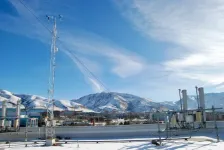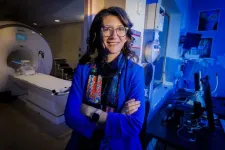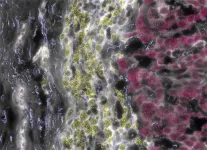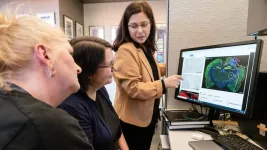(Press-News.org) As the atmosphere continues to fill with greenhouse gases from human activities, many proposals have surfaced to “geoengineer” climate-saving solutions, that is, alter the atmosphere at a global scale to either reduce the concentrations of carbon or mute its warming effect.
One recent proposal seeks to infuse the atmosphere with hydrogen peroxide, insisting that it would both oxidize methane (CH4), an extremely potent greenhouse gas while improving air quality.
Too good to be true?
University of Utah atmospheric scientists Alfred Mayhew and Jessica Haskins were skeptical, so they set out to test the claims behind this proposal. Their results, published on Jan. 3, confirm their doubts and offer a reality check to agencies considering such proposals as a way to stave off climate change.
“Our work showed that the efficiency of the proposed technology was quite low, meaning widespread adoption of the technology would be required to make any meaningful impact on atmospheric CH4,” said Mayhew, a postdoctoral researcher with the university’s Wilkes Center for Climate Science & Policy. “Then, our results indicate that if this technology is adopted at scale, then we start to see some negative air-quality side effects, particularly for wintertime particulate matter air pollution.”
To conduct the study, the Utah scientists modeled what would happen if you deployed the technology patented by a Canadian company, which is proposing to spray aerosolized hydrogen peroxide, or H₂O₂, into the atmosphere during daylight hours from 600-meter towers. These towers would approach the height of the world’s tallest radio towers.
“When that hydrogen peroxide is in the presence of sunlight, it’s going to make a really powerful oxidant, the hydroxyl radical OH,” said Haskins, an assistant professor of atmospheric sciences. “That’s a natural scrubber in the atmosphere, and it’s going to help speed up the conversion of methane to CO₂.”
Methane is a single-bonded molecule combination of carbon and hydrogen, as opposed to the double-bonded compounds that are far more common in the atmosphere. Hydroxyls are more likely to oxidize those double-bonded molecules, such as the isoprene coming off trees or volatile organic compounds, so OH is just not that efficient for breaking down methane, according to Haskins.
“OH doesn’t react fast with methane,” Haskins said. “It’s reacting with so many other things.”
Methane’s outsized impact on the climate
While carbon dioxide from fossil fuels gets much of the blame for climate change, methane is also a big contributor. Eventually, methane breaks down into carbon dioxide and water.
The primary ingredient in the natural gas burned in home appliances and power plants, methane, or CH4, packs 76 times more climate-warming punch than carbon dioxide over a 20-year timeframe. Methane persists in the atmosphere for only 12 years, but the gas is blamed for nearly a third of the rise in global temperatures since the Industrial Revolution, according to the International Energy Agency.
Anthropogenic sources, primarily oil, gas and coal operations and landfills, account for 60% of global methane emissions.
Artificially speeding up methane oxidation could slow climate change, but such geoengineering projects could carry adverse environmental impacts, which Haskins’s lab seeks to characterize. A recent report from the National Academy of Sciences concluded the unintended consequences of atmospheric methane removal technologies are likely significant but poorly understood. Haskins’ study is heeding the report’s call to scrutinize these technologies, such as the one that would release vast amounts of hydrogen peroxide.
“We could buy ourselves about 50 years and avoid some of the immediate impacts of climate change if we did this, but no one had actually previously done any side-effects studies to see what was going to happen,” Haskins said. “This is very first paper to assess any air quality side effects of such geoengineering solutions.”
Geoengineering’s potential side effects
Manipulating a system as complex as Earth’s atmosphere is an inherently dangerous action, potentially resulting in unforeseen problems.
“There’s so many feedbacks that can go on in the climate. Atmospheric chemistry is just one example. You change one thing and you think it’s going to do this, but it actually may do the opposite in one place versus the other,” Haskins said. “You have to be really careful and do these sorts of assessments. Is this a responsible thing to do? What’s the impact going to be?”
By way of example, Haskins raised the troubling history of manmade gasses called chlorofluorocarbons, or CFCs, which ate into the protective layer of ozone that shields Earth from harmful ultraviolet radiation.
“We started using CFCs in industry as propellants and refrigerants, and suddenly we cause the ozone hole,” she said. “And we’ve been dealing with the consequences of that for 40 years. And we still won’t have a fully resolved no-ozone-hole year until probably 2060, so we have to be careful of what we’re doing.”
Mayhew and Haskins used a global chemical-transport model, called GEOS-Chem, to simulate the proposal to release hydrogen peroxide from towers. The goal was to estimate how much methane would be oxidized under three different emission scenarios, from light to extreme.
Their simulation envisioned the use of 50 towers spread around North America. Replicating the company’s proposal, the medium-release scenario called for each tower to spray 612 grams, or 1.35 pounds, per second for 10 hours a day for a year.
“This proposed solution just won’t remove any meaningful amount of methane from the atmosphere. It’s not going to solve global warming. At most, we found 50 towers could reduce 0.01% of annual anthropogenic methane emissions,” Haskins said. “You’d need about 352,000 of them to remove 50% of anthropogenic methane. It’s an insane number. And if you did 50 high-emission towers, you’d still need about 43,000.”
In the meantime, places with poor wintertime air quality could see particulate pollution get much worse.
“There’s potential that future research could show that the air quality impacts of placing these towers close to methane point sources is minimal if they’re activated at certain times of the year, and far from large population centers,” Mayhew said. “If that’s the case, then this technology (or similar approaches) could play a very small role in combatting warming, but it’s clear from our work that the air-quality side effects should be placed as a central consideration for any proposed real-world implementation of technology like this.”
The study, titled “Potential Air Quality Side-Effects of Emitting H2O2 to Enhance Methane Oxidation as a Climate Solution,” was posted online on Jan. 6 in the journal Environmental Science & Technology. Funding was provided by the University of Utah’s Wilkes Center for Climate Science & Policy and was performed using the university’s Center for High Performance Computing resources.
END
Technology for oxidizing atmospheric methane won’t help the climate
Utah atmospheric scientists show proposed "geoengineering" effort to remove potent greenhouse gas could worse air quality while providing minimal benefits
2025-01-17
ELSE PRESS RELEASES FROM THIS DATE:
US Department of Energy announces Early Career Research Program for FY 2025
2025-01-17
WASHINGTON, D.C. – Today, the U.S. Department of Energy (DOE) announced it is accepting applications for the 2025 DOE Office of Science Early Career Research Program to support the research of outstanding scientists early in their careers. The program will support over 80 early career researchers for five years at U.S. academic institutions, DOE national laboratories, and Office of Science user facilities.
“The vision, creativity, and effort of early career faculty drive innovation in the basic science enterprise. The Department of Energy’s Office of Science is dedicated to ...
PECASE winners: 3 UVA engineering professors receive presidential early career awards
2025-01-17
University of Virginia School of Engineering and Applied Science faculty members James T. Burns, Coleen Carrigan and Liheng Cai received the Presidential Early Career Award for Scientists and Engineers (PECASE) on Tuesday, as did two UVA Engineering alumni, Ashutosh Giri and Ryan Johnson.
PECASE is the highest honor bestowed by the U.S. government on outstanding scientists and engineers early in their careers. According to the release from the White House, this award recognizes “innovative and far-reaching developments in science and technology.”
“This award year has been extraordinary not ...
‘Turn on the lights’: DAVD display helps navy divers navigate undersea conditions
2025-01-17
ARLINGTON, Va.—A favorite childhood memory for Dr. Sandra Chapman was visiting the USS Arizona Memorial in Pearl Harbor with her father. They hung out at the memorial so often that they memorized lines to the movie playing prior to the boat ride to the memorial.
So it’s appropriate that Chapman — a program officer in the Office of Naval Research’s (ONR) Warfighter Performance Department — is passionate about her involvement in the development of an innovative technology recently applied to efforts to preserve the area around the USS Arizona ...
MSU researcher’s breakthrough model sheds light on solar storms and space weather
2025-01-17
Images
EAST LANSING, Mich. – Our sun is essentially a searing hot sphere of gas. Its mix of primarily hydrogen and helium can reach temperatures between 10,000 and 3.6 million degrees Fahrenheit on its surface and its atmosphere’s outermost layer. Because of that heat, the blazing orb constantly oozes a stream of plasma, made up of charged subatomic particles — mainly protons and electrons. The sun’s gravity can’t contain them because they hold so much energy as heat, so they drift away into space as solar wind. Understanding how charged particles ...
Nebraska psychology professor recognized with Presidential Early Career Award
2025-01-17
Maital Neta, professor of psychology at the University of Nebraska–Lincoln, has received the Presidential Early Career Award for Scientists and Engineers, the highest honor bestowed by the U.S. government on outstanding scientists and engineers early in their careers.
Neta, Carl A. Happold Professor of Psychology, directs the Cognitive and Affective Neuroscience Lab and is resident faculty of the Center for Brain, Biology and Behavior.
Neta said she was “very grateful” for the honor, announced ...
New data shows how ‘rage giving’ boosted immigrant-serving nonprofits during the first Trump Administration
2025-01-17
As Donald Trump prepares to take office for a second term as President, research led by the University of California, Santa Cruz is demonstrating the important role nonprofits played during Trump’s first term as a counterforce that channeled public resistance to anti-immigrant policies.
The new study, published in the journal International Migration Review, shows how nonprofits that provide legal services for immigrants ended up receiving increases in public contributions in the wake of Trump's attacks on immigrants.
Previously, there had been many reported examples of this backlash effect, sometimes called ...
Unique characteristics of a rare liver cancer identified as clinical trial of new treatment begins
2025-01-17
Like many rare diseases, fibrolamellar hepatocellular carcinoma (FLC) mounts a ferocious attack against an unlucky few—in this case, children, adolescents, and young adults. Because its symptoms can vary from person to person, it’s often missed or misdiagnosed until it has metastasized and becomes lethal. Moreover, drug therapies for common liver cancers are not just useless for FLC patients but actually harmful.
But new insights about the disease, coupled with a just-launched clinical trial of a promising drug treatment, could significantly improve health outcomes. Researchers in Rockefeller University’s Laboratory of Cellular Biophysics, headed by Sanford ...
From lab to field: CABBI pipeline delivers oil-rich sorghum
2025-01-17
Researchers at the Center for Advanced Bioenergy and Bioproducts Innovation (CABBI) have developed a new sorghum variant that can outperform soybeans in oil production, with great potential as a clean source of renewable fuel.
Scientists have long worked to create new sustainable sources of vegetable oils, known as triacylglycerols (TAG), to meet the growing demand for renewable fuels like sustainable aviation fuel (SAF) and renewable diesel.
Currently, oil palm and oilseeds such as soybeans provide most TAG for renewable ...
Stem cell therapy jumpstarts brain recovery after stroke
2025-01-17
SAN FRANCISCO—Every 40 seconds, someone in the United States has a stroke. For survivors of the most common type of stroke, called an ischemic stroke, only about 5 percent fully recover. Most others suffer from long-term problems, including weakness, chronic pain, or epilepsy.
Now, scientists at Gladstone Institutes and the regenerative medicine company SanBio have shown that a cell therapy derived from stem cells can restore normal patterns of brain activity after a stroke. While most stroke treatments must be administered in the immediate hours ...
Polymer editing can upcycle waste into higher-performance plastics
2025-01-17
Polymer editing can upcycle waste into higher-performance plastics
By editing the polymers of discarded plastics, chemists at the Department of Energy’s Oak Ridge National Laboratory have found a way to generate new macromolecules with more valuable properties than those of the starting material. Upcycling may help remedy the roughly 450 million tons of plastic discarded worldwide annually, of which only 9% gets recycled; the rest is incinerated or winds up in landfills, oceans or elsewhere.
ORNL’s ...
LAST 30 PRESS RELEASES:
Numbers in our sights affect how we perceive space
SIMJ announces global collaborative book project in commemoration of its 75th anniversary
Air pollution exposure and birth weight
Obstructive sleep apnea risk and mental health conditions among older adults
How talking slows eye movements behind the wheel
The Ceramic Society of Japan’s Oxoate Ceramics Research Association launches new international book project
Heart-brain connection: international study reveals the role of the vagus nerve in keeping the heart young
Researchers identify Rb1 as a predictive biomarker for a new therapeutic strategy in some breast cancers
Survey reveals ethical gaps slowing AI adoption in pediatric surgery
Stimulant ADHD medications work differently than thought
AI overestimates how smart people are, according to HSE economists
HSE researchers create genome-wide map of quadruplexes
Scientists boost cell "powerhouses" to burn more calories
Automatic label checking: The missing step in making reliable medical AI
Low daily alcohol intake linked to 50% heightened mouth cancer risk in India
American Meteorological Society announces Rick Spinrad as 2026 President-Elect
Biomass-based carbon capture spotlighted in newly released global climate webinar recording
Illuminating invisible nano pollutants: advanced bioimaging tracks the full journey of emerging nanoscale contaminants in living systems
How does age affect recovery from spinal cord injury?
Novel AI tool offers prognosis for patients with head and neck cancer
Fathers’ microplastic exposure tied to their children’s metabolic problems
Research validates laboratory model for studying high-grade serous ovarian cancer
SIR 2026 delivers transformative breakthroughs in minimally invasive medicine to improve patient care
Stem Cell Reports most downloaded papers of 2025 highlight the breadth and impact of stem cell research
Oxford-led study estimates NHS spends around 3% of its primary and secondary care budget on the health impacts of heat and cold in England
A researcher’s long quest leads to a smart composite breakthrough
Urban wild bees act as “microbial sensors” of city health.
New study finds where you live affects recovery after a hip fracture
Forecasting the impact of fully automated vehicle adoption on US road traffic injuries
Alcohol-related hospitalizations from 2016 to 2022
[Press-News.org] Technology for oxidizing atmospheric methane won’t help the climateUtah atmospheric scientists show proposed "geoengineering" effort to remove potent greenhouse gas could worse air quality while providing minimal benefits






